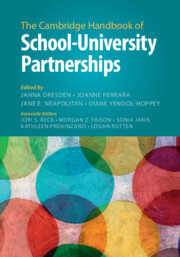Book contents
- The Cambridge Handbook of School–University Partnerships
- The Cambridge Handbook of School–University Partnerships
- Copyright page
- Contents
- Figures
- Tables
- Contributors
- Foreword
- Preface
- Acknowledgments
- Part I The History and Conceptual Foundations of School–University Partnerships
- Part II Teachers and Learning to Teach in School–University Partnerships
- Part III Equity and Student Learning in School–University Partnerships
- Part IV Leadership in School–University Partnerships
- Introduction to Part IV: Leadership in School–University Partnerships
- 25 Teacher Leaders in School–University Partnerships
- 26 Aspiring and Thriving
- 27 Embracing Complexity Leadership in School–University Partnerships
- 28 The Role of Leadership in Designing School–University Partnerships
- 29 Commentary: Leadership in and for School–University Partnerships
- 30 Commentary: Using Third Spaces, Boundary Spanning, and Brokering to Describe School–University Leadership
- 31 Commentary: Perspectives on Leadership in and for School–University Partnerships
- Part V Community Schools as School–University Partnerships
- Part VI Inquiry and Innovation in School–University Partnerships
- Part VII Funding, Policy, and the Politics of School–University Partnerships
- Part VIII Looking at School–University Partnerships across Geographic and Cultural Borders
- Index
- References
26 - Aspiring and Thriving
Community School Principals and the Benefits of University-Assisted Partnerships
from Part IV - Leadership in School–University Partnerships
Published online by Cambridge University Press: 05 November 2025
- The Cambridge Handbook of School–University Partnerships
- The Cambridge Handbook of School–University Partnerships
- Copyright page
- Contents
- Figures
- Tables
- Contributors
- Foreword
- Preface
- Acknowledgments
- Part I The History and Conceptual Foundations of School–University Partnerships
- Part II Teachers and Learning to Teach in School–University Partnerships
- Part III Equity and Student Learning in School–University Partnerships
- Part IV Leadership in School–University Partnerships
- Introduction to Part IV: Leadership in School–University Partnerships
- 25 Teacher Leaders in School–University Partnerships
- 26 Aspiring and Thriving
- 27 Embracing Complexity Leadership in School–University Partnerships
- 28 The Role of Leadership in Designing School–University Partnerships
- 29 Commentary: Leadership in and for School–University Partnerships
- 30 Commentary: Using Third Spaces, Boundary Spanning, and Brokering to Describe School–University Leadership
- 31 Commentary: Perspectives on Leadership in and for School–University Partnerships
- Part V Community Schools as School–University Partnerships
- Part VI Inquiry and Innovation in School–University Partnerships
- Part VII Funding, Policy, and the Politics of School–University Partnerships
- Part VIII Looking at School–University Partnerships across Geographic and Cultural Borders
- Index
- References
Summary
School principals play a critical role in developing and nurturing effective school–university partnerships (SUP). This is especially true in community school contexts, a type of SUP where public schools benefit from partnerships with community resources. To provide a more nuanced understanding of the leadership skills required for principals to do partnership work, the purpose of this chapter was twofold: (1) to describe what is known about the role of principals engaged in partnership work, and (2) to provide examples from the authors’ own research on how school principals can advance partnerships, especially with universities, to foster an effective SUP. Implications for school principals and university partners are discussed, as are challenges school principals encounter when attempting to advance sustainable SUPs. The chapter concludes with policy and practice considerations for school and university leaders.
Information
- Type
- Chapter
- Information
- The Cambridge Handbook of School–University Partnerships , pp. 399 - 414Publisher: Cambridge University PressPrint publication year: 2025
References
Accessibility standard: WCAG 2.1 AA
Why this information is here
This section outlines the accessibility features of this content - including support for screen readers, full keyboard navigation and high-contrast display options. This may not be relevant for you.Accessibility Information
Content Navigation
Allows you to navigate directly to chapters, sections, or non‐text items through a linked table of contents, reducing the need for extensive scrolling.
Provides an interactive index, letting you go straight to where a term or subject appears in the text without manual searching.
Reading Order & Textual Equivalents
You will encounter all content (including footnotes, captions, etc.) in a clear, sequential flow, making it easier to follow with assistive tools like screen readers.
Visual Accessibility
You will still understand key ideas or prompts without relying solely on colour, which is especially helpful if you have colour vision deficiencies.
Structural and Technical Features
You gain clarity from ARIA (Accessible Rich Internet Applications) roles and attributes, as they help assistive technologies interpret how each part of the content functions.
